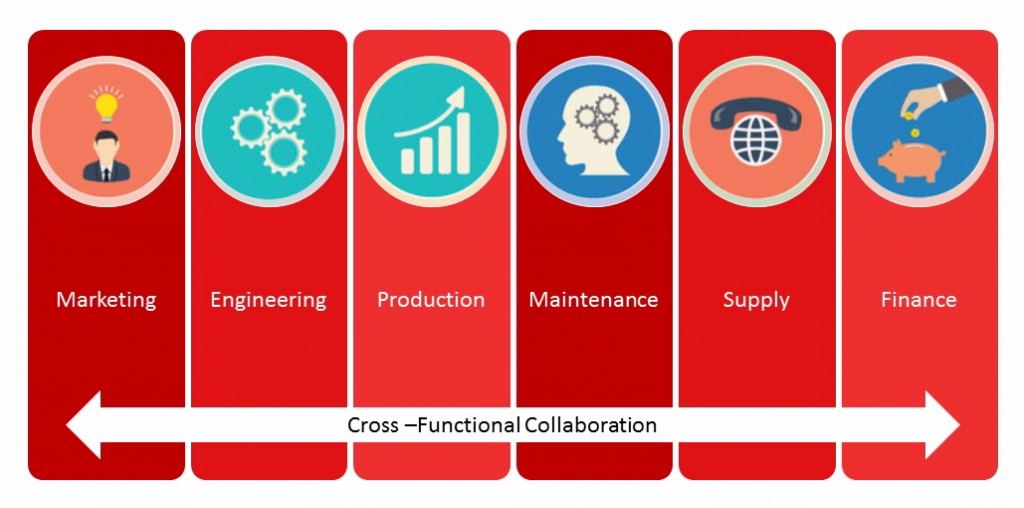Accelerate Strategic Success With Cross Functional Collaboration
Cross Functional Collaboration describes a scenario where people from different teams or functions (sales, marketing, HR, or engineering) come together towards achieving a common goal. In other words, it describes a group of people from different departments within a business who are working to solve a specific problem.
Why you should think about Cross-Functional Collaboration?
Cross-functional collaborations lead companies to work better and innovate more!
By working together teams are able to bring about significant improvements within their organizations. Hence, every business owner/manager cross-functional collaboration must regard it as a powerful tool for the attainment of key business goals.
Just think about for 1 minute about the following –
Is your business not growing despite everyone working really hard?
How many of your teams are working towards delivering higher value to your end customers?
What would happen if your teams always worked in separate silos?
Cross Functional Collaboration can be as basic as day-to-day responsibilities e.g. when Marketing and Customer support team up on social media, to more advanced responsibilities like Research and Sales teaming up on the development of a new product.
Cross Functional Collaboration can help to improve teamwork within an organization, thereby leading to a more significant level of commitment towards improvement. It also helps to improve the level of communication that exists between a diverse group of people.


One of the earliest pioneers of Cross Functional Collaboration is Northwestern Mutual. Northwestern Mutual, an insurance company in the 1950s, began to build cross-functional teams made of members from its financial, investment and actuarial departments. The goal of this team was to study how computers would impact the business world.
The result, the company was able to create one of the first information systems department which helped give the company a significant edge when computers began to pervade every industry. Currently, the company boast of cross functional teams in virtually every facet of its organization. This goes to show the unimaginable value cross-functional teams can deliver.
Benefits of Cross Functional Collaboration
Collaboration is highly critical to improving the capacity and performance of any business. Below are some of the practical benefits of Cross Functional Collaboration:
1. Different perspective creates innovation:
We are all unique and tend to see life and everything in it from a different perspective. This is similar to what is obtainable in a business. When you bring people from different units of a business or organization together, each person will see the same problem from their own unique perspective. The view from someone in Production will most likely differ from that of the person in Sales. Bringing these people together can help to shed light on the process problem and deliver solutions that are satisfying to everyone.


Apple employed cross functional team to create the revolutionary iPhone. They gleaned experts from different departments across the organization to start what was to become a smartphone revolution. They are regarded as one of the greatest teams of all time bringing about a new innovation.
2. Increased momentum of change:
It is generally known that the bigger an organization, the longer it takes to make decisions. This is due to the number of people or units that would need to be involved in the final decision process. Cross Functional Collaboration helps to cut down drastically on the time it takes an organization to arrive at a decision. Involving people from different units from the beginning helps to secure trust, empathy, and buy-in. Everyone is on the same page right from the onset.
3. Everyone learns more:
When there is efficient cross functional collaboration, everyone learns more, everyone’s a winner. Collaboration brings people from different sections/departments of business together thereby encouraging the cross-pollination of ideas and knowledge. Each person would then be aware about what the other person does. They can understand their role and how it fits into the larger picture. It is an added advantage for any organization if, for instance, the Marketing coordinator understands how Finance process payment to vendors.


The managers of Bell Labs employed this technique when they brought together scientists and engineers together, each with unique skill sets. The executives were able to create a risk-free corporate culture that regarded failure as an integral part of growth.
This experiment led to the invention of the vacuum tube. This has revolutionized thousands of industries. The more people across your various departments understand the basics of each other’s specialties, the more productive your entire company would be.
4. Old ideas can be challenged:
It is quite difficult for anyone to genuinely find fault in his/her own work. Therefore having an extra set of eyes to proofread and extract errors can go a long way. This becomes a most crucial step towards improving the quality of your delivery. Cross functional collaboration offers an avenue for others to have a look at whatever is being done. The syndrome of “the way we have always done it” can be done away by giving room for fresh perspective.
5. A level playing field:
While hierarchy and structure may be essential in every organization. Ideas are not exclusive to this section of the organization. Sometimes a more multi-directional approach is required to achieve a more productive result. Cross-platform collaboration ensures that not all ideas originate from the executives or the top Management. It ensures that people from any level can contribute and participate in the creation of new ideas, which increases engagement on all fronts.
In the mid-2000s, Cisco instituted a cross-functional team which included representatives from software engineering, marketing, quality assurance, manufacturing, and customer service. The aim was to heighten security for router lines. The team was made of a three-layer structure.
About 100 people attended the meeting. This included a core group of 20 who communicated back to their functions. There was also a small governance team at the top, which comprised of two vice presidents, the company’s chief development officer and the head of the core team of 20 people.
This cross functional governance worked as Cisco is currently the number one router security vendor.
Summary
Cross Functional Collaboration is meant by the accumulation of different functional expertise to achieve a common goal. With such diversity, an organization can achieve a culture of continuous improvement in which employees take ownership of problems and can take initiative to bring a common solution. Also, this improves team coordination, thereby, leading to great levels of commitment. Collaboration is a critical process of teambuilding which enhances the performance of the organization.









